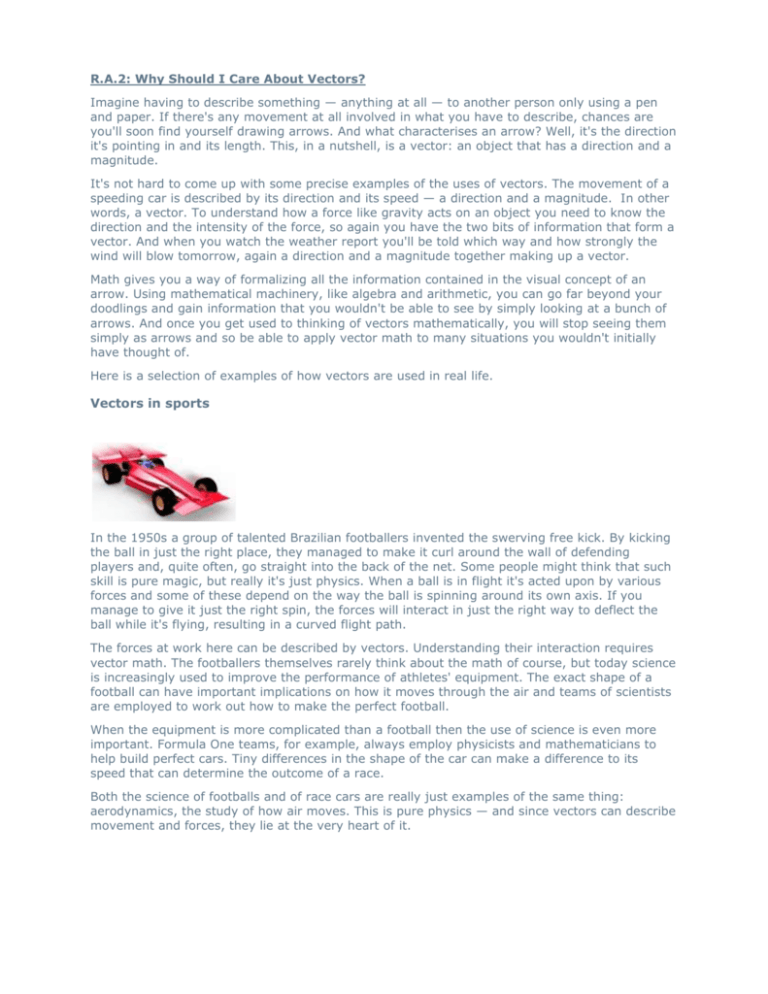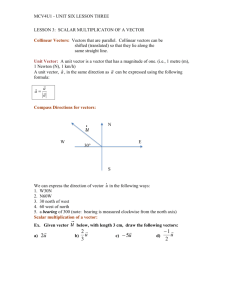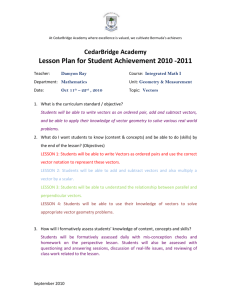File
advertisement

R.A.2: Why Should I Care About Vectors? Imagine having to describe something — anything at all — to another person only using a pen and paper. If there's any movement at all involved in what you have to describe, chances are you'll soon find yourself drawing arrows. And what characterises an arrow? Well, it's the direction it's pointing in and its length. This, in a nutshell, is a vector: an object that has a direction and a magnitude. It's not hard to come up with some precise examples of the uses of vectors. The movement of a speeding car is described by its direction and its speed — a direction and a magnitude. In other words, a vector. To understand how a force like gravity acts on an object you need to know the direction and the intensity of the force, so again you have the two bits of information that form a vector. And when you watch the weather report you'll be told which way and how strongly the wind will blow tomorrow, again a direction and a magnitude together making up a vector. Math gives you a way of formalizing all the information contained in the visual concept of an arrow. Using mathematical machinery, like algebra and arithmetic, you can go far beyond your doodlings and gain information that you wouldn't be able to see by simply looking at a bunch of arrows. And once you get used to thinking of vectors mathematically, you will stop seeing them simply as arrows and so be able to apply vector math to many situations you wouldn't initially have thought of. Here is a selection of examples of how vectors are used in real life. Vectors in sports In the 1950s a group of talented Brazilian footballers invented the swerving free kick. By kicking the ball in just the right place, they managed to make it curl around the wall of defending players and, quite often, go straight into the back of the net. Some people might think that such skill is pure magic, but really it's just physics. When a ball is in flight it's acted upon by various forces and some of these depend on the way the ball is spinning around its own axis. If you manage to give it just the right spin, the forces will interact in just the right way to deflect the ball while it's flying, resulting in a curved flight path. The forces at work here can be described by vectors. Understanding their interaction requires vector math. The footballers themselves rarely think about the math of course, but today science is increasingly used to improve the performance of athletes' equipment. The exact shape of a football can have important implications on how it moves through the air and teams of scientists are employed to work out how to make the perfect football. When the equipment is more complicated than a football then the use of science is even more important. Formula One teams, for example, always employ physicists and mathematicians to help build perfect cars. Tiny differences in the shape of the car can make a difference to its speed that can determine the outcome of a race. Both the science of footballs and of race cars are really just examples of the same thing: aerodynamics, the study of how air moves. This is pure physics — and since vectors can describe movement and forces, they lie at the very heart of it. Vectors and visuals Vector maths is used extensively in computer graphics. Suppose you want to create an image on a computer screen. One way of doing this is to tell the computer the exact colour of each pixel on the screen. This requires a lot of memory and has another disadvantage: if you'd like the image to move, for example to give the viewer the impression that he or she is moving around a scene, you need to constantly renew the information of the pixel colours from scratch. It's much easier to describe your set-up mathematically. Vectors are very useful here. Say, for example, that you're creating a scene lit by sunlight and ruffled by a strong wind. The sunlight and wind both come from a specific direction and have a certain intensity — so both can be represented by vectors. Using these vectors you can create a program that calculates exactly how an object in the scene should be coloured and move to give a realistic impression of lighting and wind. Even better, you can write your program so that the vectors representing sun and wind constantly change their direction and magnitude — thus you can create gusts of wind and clouds passing overhead. Vectors and language Our highly developed language is one thing that separates us from all the other animals on our planet. For this reason many people believe that language and the way we use it can tell us a lot about who we, as humans, really are. The study of language — called linguistics — has become an important field within psychology. But there are also more practical reasons for trying to understand the way language works. Search engines and word processors work by picking up on certain structures within texts to find the websites most relevant to your search and to weed out grammatical mistakes in your texts. The more they understand language, the more efficient they'll get. The same goes of course for automated speech recognition systems like those that sometimes answer the phone when you ring up a company or information line. Both psychologists and people involved in computing want to understand the structures within language. Maths is a great tool for capturing structure and vectors seem to be especially useful for understanding language. Words or bits of text can be represented by vectors and vector maths can help you see how the different components of a text interact, helping you to find structures within a text that you might not see otherwise. Reading Assignment #2 Questions 1. 2. 3. 4. List 3 practical areas where vectors are used in real life. What 2 components is a vector made up of? What symbol is used to represent a vector quantity? Provide a detailed description of a how vectors can be used to describe a physical reality(choose only 1)? 5. Describe two facts from your reading about vectors that interested you most.





